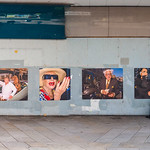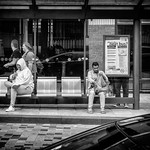- BBC Radio 2 In The Park confirmed as Preston’s mystery music festival
- Preston City Council local elections 2024 candidates list set out
- Blog Preston reaches crowdfunding goal for expanded arts and culture coverage
- Harris Institute owners move to squash ‘for sale’ rumours
- “Unacceptable” and “must do better” as Preston records highest rough sleeper count since records began
The lost Castle Inn, Preston’s coaching inn and meeting place
Posted on - 10th April, 2022 - 7:00pm | Author - Geoffrey Whittaker | Posted in - Flag Market, History, Preston City Centre, Preston News
One of the earliest inns in Preston was the Castle Inn. It was in Cheapside, off Market Square. Built in 1623, it once stood alone. Gradually new buildings encroached and the 1990s saw it demolished for new shops.
Advertisement
The Castle Inn was a long thin building and was much bigger than the frontage would suggest. It had three floors and many rooms.
Coaching days
The Castle Inn was used as a departure and arrival point for coaches from the earliest days of the town. Extensive stable facilities ran along the back of the building.
Even as late as 1853, Market Square saw coaches running to Blackpool, Burnley, Kirkham, Padiham and Whalley. Blackpool was served twice a week.

Historians were enthralled by the charm of the Market Square, with its quaint shops and large area.
Market Place described in 1837

Whittle’s History of Preston (1837) describes Market Square:
“Very spacious, consists of beautiful shops, elegantly adorned with bay windows, dressed out in the most fashionable manner by the respective trades people within its precincts. Drapers, milliners, grocers, straw-hat-makers, haters, booksellers, brush maker, shoe warehouses… etc.”
Preston became a major market town; its geographical position and easy access to the sea made it an early trade centre. The town grew up around the parish church and Church Street. The first market was nearer to the church. Consequently, Church Street and Fishergate became the main axis. Later, a large field to the north of Fishergate became the market place.

Politics also played a part in the history of the Castle Inn.
William Cobbet runs in Preston

In 1826 William Cobbet stood as a candidate for Preston. He was a radical who supported the workers and was an expert publicist. He was known as the prince of the pamphleteers. On visiting Preston he was greeted with rapturous crowds, however he did not win. The seat was taken by E.G. Stanley (Whigg) and John Wood (Liberal).
Interestingly the Castle Inn had a ‘news room’. These were rooms set aside to contain newspapers and leaflets. Entry was by subscription only, to keep out the lower classes. There were several news rooms in Preston and they had various rules, including. Rule No.4, No paper or publication to be taken out of the room on pain of expulsion.
The Castle Inn building also had some interesting architectural features that were saved.
Architectural survivors
In 1910 the Castle Inn became Castle Chambers. It was then home to several solicitors offices. Some of the original features were removed. One such was the Jacobean staircase.

The Stone House in Broughton, built in 1911, contains the Jacobean staircase from the Castle Inn. Early 17th century stairways were characterised by ornate pilasters and columns.

Cheapside today

The original medieval town hall and other buildings were removed to build the Harris. The Gothic Victorian town hall burned down in 1947 and was replaced by the current, unloved tower block. The Castle Inn itself was demolished and replaced by shops in the 1990s
Read more: See the latest Preston news and headlines











 Advertisement
Advertisement